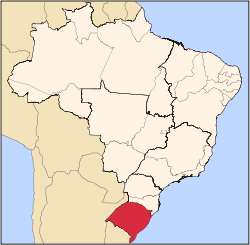São Gabriel, Rio Grande do Sul
| São Gabriel | |
|---|---|
| Municipality | |
 Location within Rio Grande do Sul | |
 São Gabriel Location in Brazil | |
| Coordinates: 30°20′9″S 54°19′12″W / 30.33583°S 54.32000°WCoordinates: 30°20′9″S 54°19′12″W / 30.33583°S 54.32000°W | |
| Country |
|
| State | Rio Grande do Sul |
| Time zone | UTC-3 (UTC-3) |
| • Summer (DST) | UTC-2 (UTC-2) |
São Gabriel is a municipality in the state Rio Grande do Sul, Brazil.
Notable Persons
José Plácido de Castro (1873–1908), leader in the Acre War in which Acre became independent of Bolivia, was born in São Gabriel.[1] It is the birthplace of the Field Marshal Mascarenhas de Morais (1883–1968) and the Baron of Candiota (c.1815–1894).
On 7 February 1756 Chief Sepe Tiaraju was killed here at the hands of Portuguese and Spanish soldiers.[2] He was the principal leader of the Brazilian resistance movement against the implementation of the Madrid Treaty during the years 1754–1756. He became a symbol of courage to the indigenous population in South America struggling for their own land.
Paleontology
In the vicinity of the city of São Gabriel fossils of ancient amphibians and reptiles whose ages range from the Permian to the Triassic have been found . [3][4]
Three vertebrate-bearing geological formations and localities are as follows:
- Irati Formation (Passo São Borja). Age: Early Permian.
- Rio do Rasto Formation (Posto Queimado). Age: Late Permian and/or Early Triassic.
- Sanga do Cabral Formation (Abandoned railroad between Dilermando de Aguiar and São Gabriel). Age: Late Triassic.
See also
References
- ↑ Herói Brasileiro: Plácido de Castro (in Portuguese), Folha de S. Paulo: Enciclopédia Mirador Internacional, retrieved 2016-07-04
- ↑ https://translate.google.com/translate?hl=en&sl=pt&u=http://portaldasmissoes.com.br/municipios/ubiretama/noticias/view/id/100/7-de-fevereiro-de-1756-morre-sepe-tiaraju.html&prev=search
- ↑ Stereospondyls
- ↑ Mesosaurs
